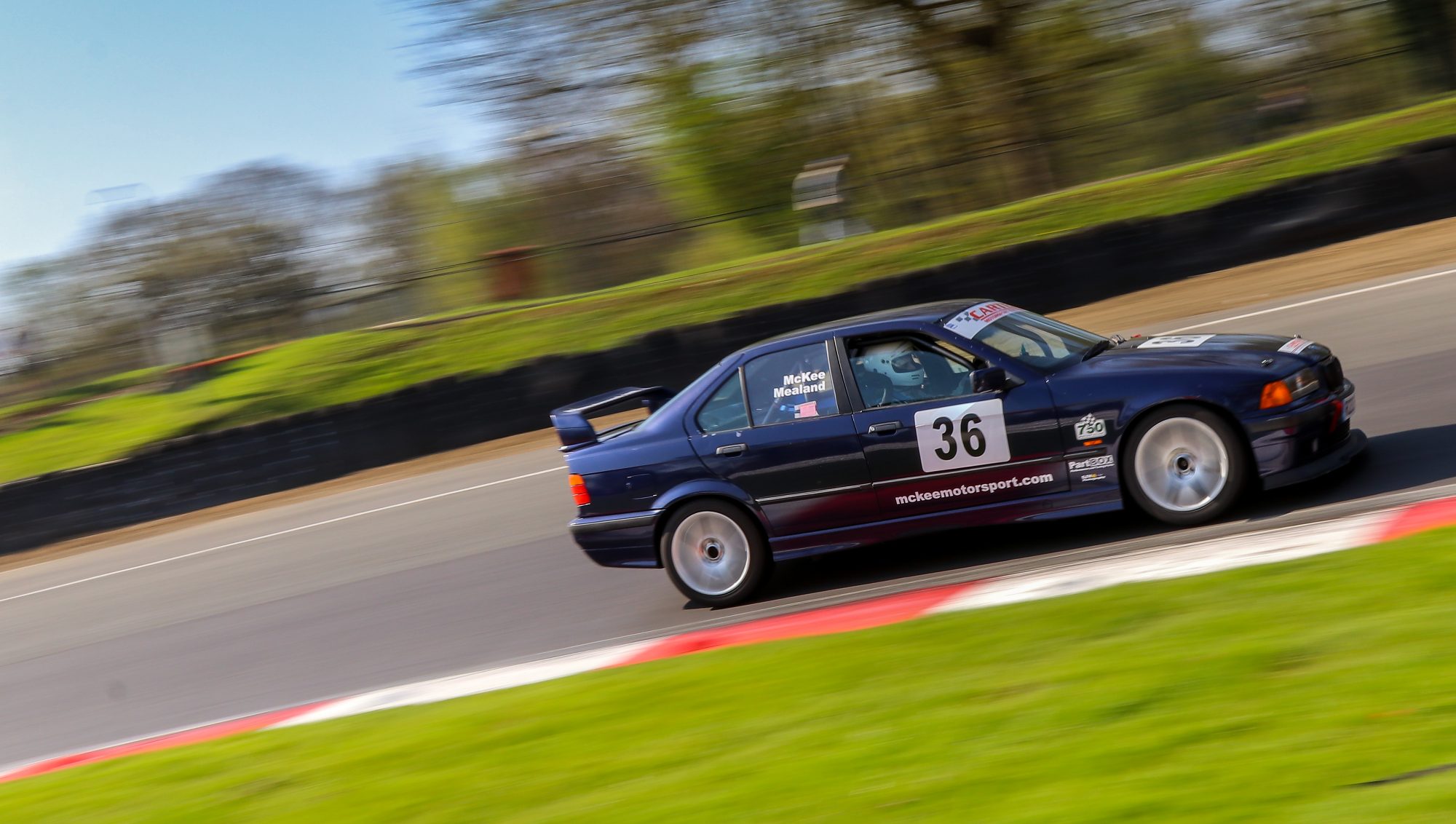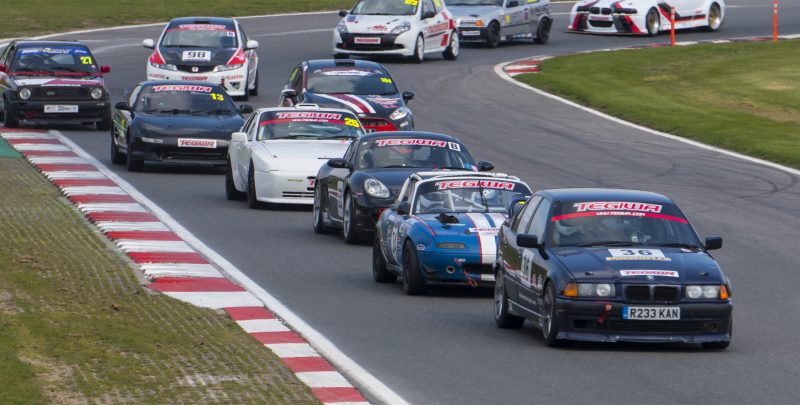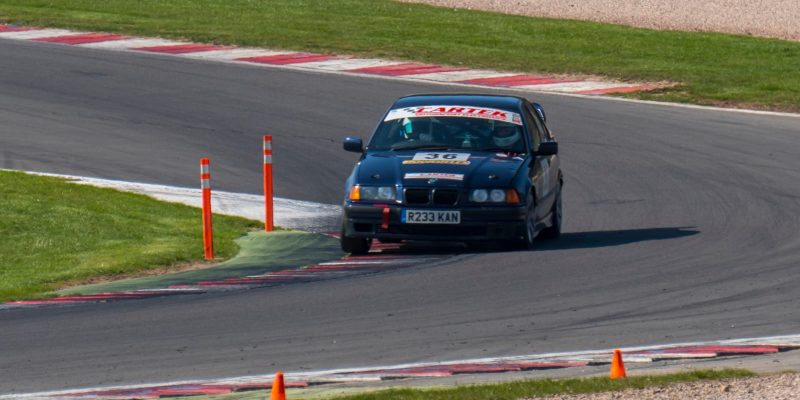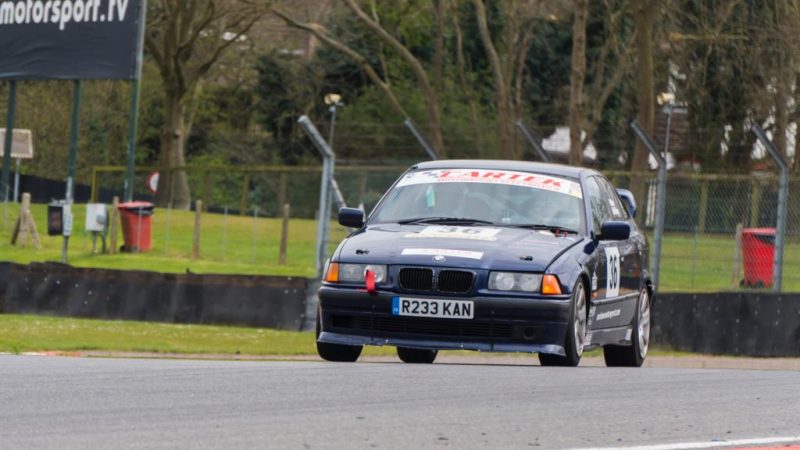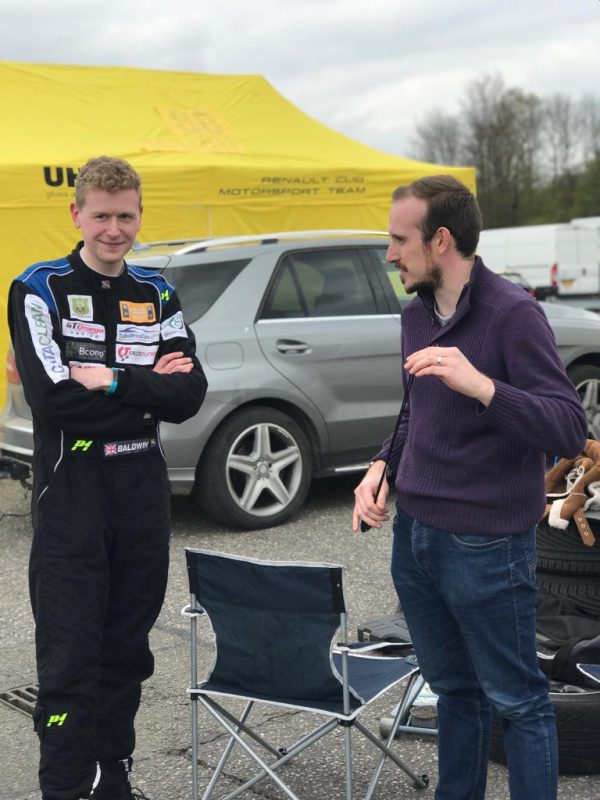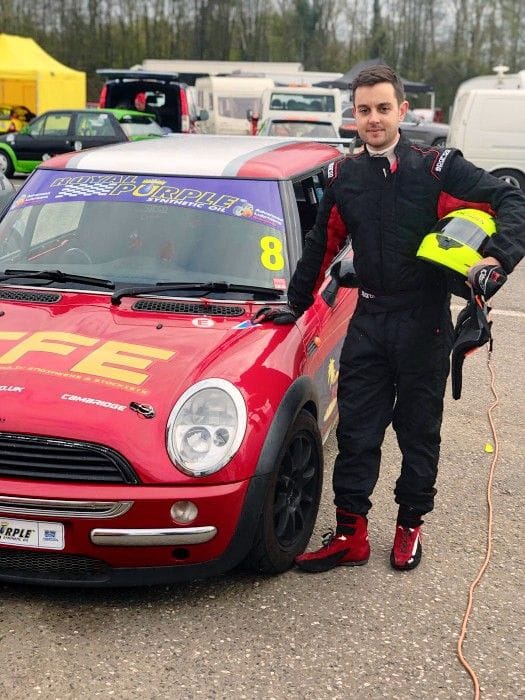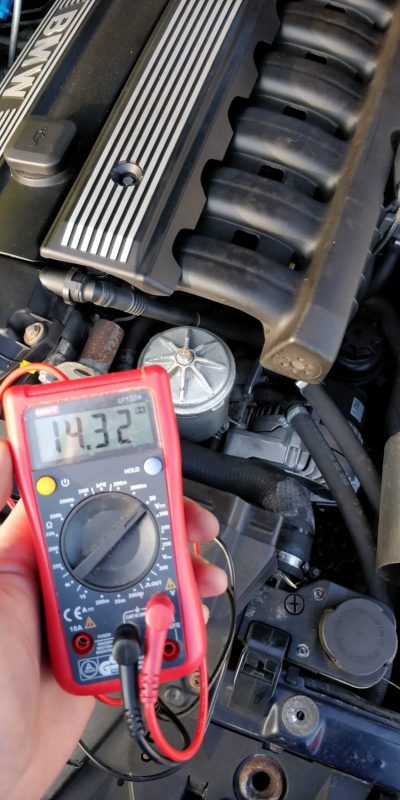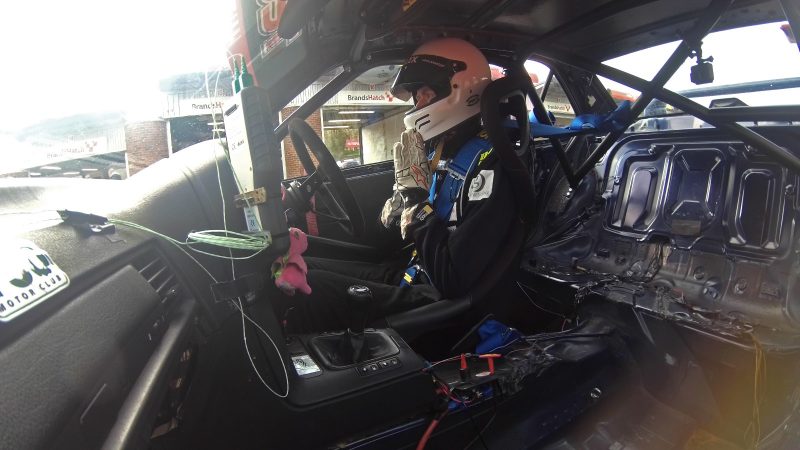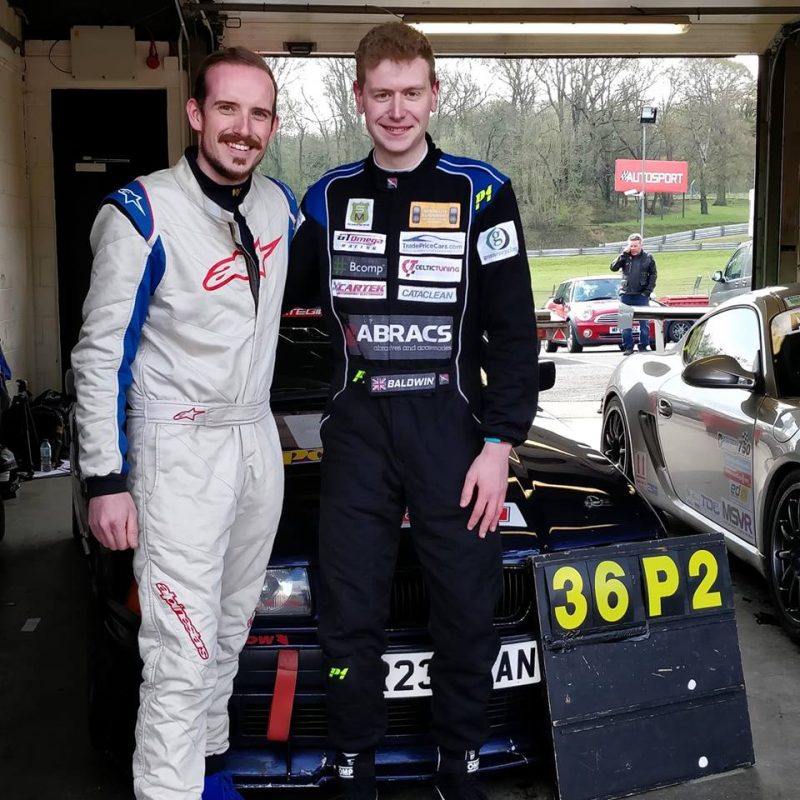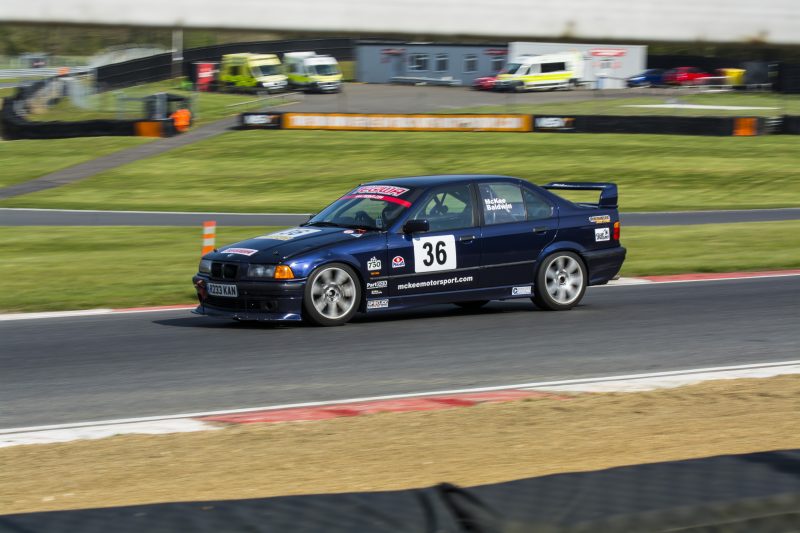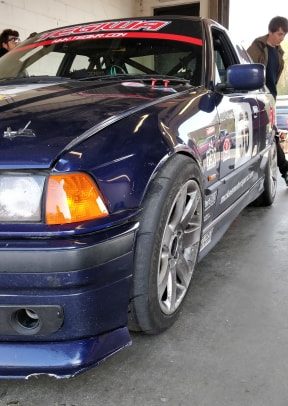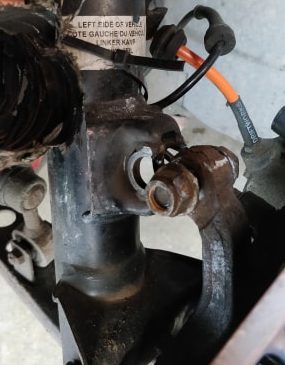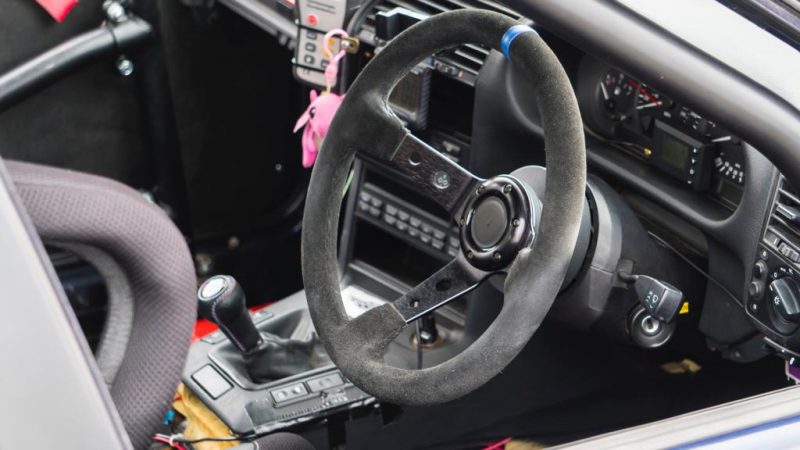It’s all fun and games until someone loses an eye…
After a long winter of work and upgrades on the 328i, the 750 Motor Club’s 2019 racing season finally kicked off at Brands Hatch in April. This first meeting came with a difference – it would mark the debut of Alex Baldwin, shooting the “Dream Chaser” documentary about entering club motorsport.
Alex first got in touch with me 12 months ago, looking for a car and willing participant for his project. Never being one to turn down the opportunity to promote club racing and get more drivers involved, I jumped at it, and the plan evolved into running the car at Donington Park for Alex to acclimatise to it, then test and race at Brands Hatch in the first round of the 750MC Roadsports series.
That acclimatisation at Donington was very reassuring. You can generally get quite an accurate idea of how someone will drive by their attitude and approach, but you’re never quite certain until you sit beside them on a circuit! I was immediately put at ease – Alex clearly knew exactly how the line was supposed to look, and had a good feel for the car straight away. We spent the day at Donington developing him rapidly, including several solo stints of near-race length into the afternoon, clocking up over 200 miles. The improvement was marked, and as you can see from the trackside photography, commitment levels certainly weren’t lacking!
Two weeks later we arrived at Brands Hatch for the race weekend. We booked an afternoon’s testing on the Friday, for a number of reasons: Alex knew Brands already, but an hour’s running to adapt his knowledge to driving this car here would be very valuable. It also gave him his first exposure of driving in “live” motorsport traffic, which is a very different experience to a track day! Testing is much more like a qualifying session, with a wide variety of race cars all being driven at their limits, and overtaking permitted wherever possible.
The results, again, were extremely encouraging. Alex improved his laptimes steadily down to 58.09 seconds around Brands’ 1.2 mile Indy circuit. Compared to my qualifying time of 57.21 last season, this was fantastic work for a novice driver at his first-ever meeting! Perhaps more impressive and certainly useful for race pace was his ability to put in consistently quick laps, once managing 5 in a row all under 59 seconds.
We wrapped up Friday’s running feeling very pleased with both car and driver. That is, until a faint battery charge warning started flickering on the dashboard while I was in the scrutineering queue.. The car passed through with no problem and was declared fit to race on Sunday, but expired in the paddock shortly afterwards. It wasn’t clear whether battery or alternator had failed, so at 8pm I was wandering the paddock to borrow some of the few pieces of equipment I don’t usually carry – a voltmeter, and a jump pack! The kindness of fellow competitors had the car started again for long enough to tell me that yes, the alternator wasn’t charging. 8.5 volts across the battery with the engine running. After checking wiring throughout the car for any broken connectors or potential drains, I resigned to trying to find a spare alternator the next day.
Saturday presented a rare “spare day” at a circuit, so I put myself to work helping guide Hot Hatch novice Tom Day through his first race meeting. I remembered the stress and doubt of my first time well enough, so I hope having someone on hand to get him in the right place at the right time, give times and feedback on the pit board, and generally talk through everything was helpful! Certainly he seemed to have a great day and made an impressive debut in challenging conditions. Cheers Tom!
I also met another budding driver in the form of “Race Dreamer” Rob Dowsett, who’s touring the country’s paddocks and speaking to drivers from big names in Blancpain right down to, well, me.. Rob’s racing in karts while building up knowledge and budget to make his entry into circuit racing with cars, and I was more than happy to talk him through what I’m doing and break down some of the perceived barriers to going racing.
Back to work, I found that David Drinkwater actually had an E36 alternator, for his Compact race car and to my eternal gratitude handed it over for me to try. The mounting points for his four-cylinder engine turned out to be totally different to my six-cylinder one, so I couldn’t use it, but the gesture really illustrates how much a family the club paddocks are.
Speaking of family, they became the saviour. As my only transport – the race car – wasn’t going anywhere, I couldn’t get parts, but my long-suffering Mum picked up a new alternator en route to the circuit Saturday evening. Half an hour later it was fitted, the car fired, and I saw the most relieving electrical readout of the year!
The car was running, charging, and we were going to go racing the next day.
Sunday dawned cold and changeable. No sooner had I fitted dry tyres than a hailstorm started, and the weather for the next two hours into qualifying looked decidedly uncertain. As it became clear the session would start wet but likely dry towards the end, we chose to send Alex out first. Not only would it let him get some wet-weather experience in case it rained during the race, but it also let us run him for longer, so I could jump in towards the end of the session and try and set a laptime. Alex pointed out that he’d never actually driven a wet circuit in a car at all, and precious little even in karts, a thought which appeared front and centre in his mind as he waited to go out..
Predictably, he needn’t have worried. The circuit was much wetter than it looked, but Alex kept the car smooth and consistent and completed his qualifying laps without incident. After ten laps he came into the pits to hand the car over to me on a rapidly drying circuit. I hadn’t driven at Brands for ten months and really had no idea how the car would behave, but there followed a rapid session of adapting and that hugely satisfying feeling of the car being faster every lap. Not only was I improving but the circuit was drying, so grip got better every time round, and the times tumbled until a 57.54 was produced. Emily told me via the pit board that put us first in class, but not for long.. right at the end of the session I got bottled up behind a Class A car, and wasn’t able to improve while the circuit dried a bit further and the 328i of Lee and Jeff Piercey was able to beat us to pole by half a second.
We found afterwards that we were going to start 10th overall, of 35 cars. Not bad for Class C…
Four hours later, it was showtime. I’d used some of the time in the break to check everything on the car – particularly as I’d rebuilt most of the rear end, it was good practice to ensure everything was torqued properly and still on its paint marks. All looked well. We also changed both left-hand tyres for some spare part-worns, still the same Nankang AR1s, but with much more tread life remaining to see out the 45-minute race.
We elected to put me in the car for the start, as Alex wanted to take the chequered flag and avoid the risky business of a 35-car start into the infamous Paddock Hill corner. I planned to drive for 15 to 20 minutes, keeping the car safe and as far up the order as possible before handing over to Alex to make his racing debut and bring the car home.
Unfortunately, it didn’t work out that way. I had a good start and after a few short battles maintained position, though the tyres fitted since qualifying were clearly not in such good condition and I was struggling for grip in right-handers. Not being one to miss a chance, Dan Rogers pounced, and after running his MX-5 side-by-side for three corners finally got the better of me into Graham Hill Bend. I hung on as best I could, but ultimately decided third place was a good position to consolidate.
There I stayed, carving through the traffic presented by the 116i Trophy guests on our grid. Such was the pace difference that in some cases, two or even three 116is needed to be passed in a single corner, which made for some interesting set-pieces as I tried to get through without disturbing their race, or losing time in my own! I was enjoying myself as the race leaders in Class A came through, and interested to note that I struggled to turn into Paddock Hill when directly behind the huge rear wing of Matthew Weymouth’s E36 M3. Perhaps that front splitter is doing something after all. I was still close behind him through the Druids hairpin, and again suffered understeer on exit, running wide onto the aggressive exit kerbs. It’s something you try to avoid doing for the whole race, but not uncommon. Nonetheless, the car felt strange afterwards – I was holding some left steering lock to keep her straight.
Immediately I wondered if the geometry had been knocked out by the kerb, but through the left-handed Graham Hill Bend everything felt OK. I commited to the left-hander of Surtees at full pace, but the moment I tried to turn right into Clearways, a serious problem became obvious. The car felt like it was collapsing over its front-left corner as soon as I loaded it up, and the steering forces were all wrong. I immediately brought it into the pits, jumped out, shed helmet and gloves and ran around with the jack to check the front suspension. I found a front tyre sitting like this.
Hoping against hope that there was a simple failure like a snapped or missing bolt – despite them all being tight before the session – I lifted the car and got the wheel off while Alex strapped in. I found a terminal failure.
The wheel hub’s top bolt had torn out of its mounting eye on the suspension strut. The uncontrolled cornering loads had bent the bottom bracket so far that it couldn’t be reseated, and wouldn’t have been safe even it we’d got it clamped. There was no way we could send the car back out. We were forced to retire from the race, and Alex didn’t get his shot.
The pain of a retirement was entirely new to me. Over the last five years, this near-bulletproof car had seen the chequered flag at every single track day and race meeting she’d ever entered. While it’s seen as a part of racing, inevitable sooner or later, not finishing a race wasn’t really ever on the agenda. The feeling was made altogether worse by denying Alex his long-awaited chance to realise his dream, though he handled the situation like a professional, which helped.
Not only were we out of the race, the car couldn’t be driven, and I needed a way to get it home. Some brainstorming in the garage found a couple of half-feasible ways to get the car straight enough to drive, but this wasn’t a short hop, I had to do 140 miles of M25 and M40 and I wasn’t prepared to risk a temporary fix. It was the racing family that saved me again. Neil McDonald of Automac not only had suspension struts that would fit, he turned out on a Sunday evening to meet Mum (told you she was long-suffering) and hand a set over. I’m incredibly grateful to Neil for going out of his way to help us. Two hours later they were in the garage, and shortly after that I had a car I could safely drive home. Despite her unluckiest meeting yet, she made it back.
Which was a good job, with only eight days until the opening round of the Club Enduro Championship…
Much of this photography kindly furnished by AFR Productions and @photojcs
